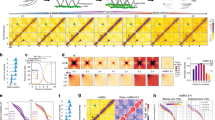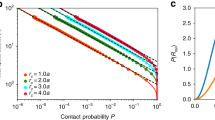Abstract
MANY eukaryotic chromosomes stained with quinacrine or by one of the Giemsa banding techniques show numerous bands in the chromosome arms. These have been termed Q or G-bands1. Autoradiographic studies show they correlate well with late replicating heterochromatin2 and a number of biochemical and immunological procedures indicate the DNA in these regions is relatively AT-rich3–7. This raises the following enigma: as each banded region has enough DNA to hold several thousand genes5 how is it possible for a given region of the chromosome to accumulate enough AT-rich genes to lead to a discernible band? In view of the rather gross folding pattern of chromatin in mitotic chromosomes8 only a markedly non-random distribution of AT-rich regions could produce banding.
This is a preview of subscription content, access via your institution
Access options
Subscribe to this journal
Receive 51 print issues and online access
$199.00 per year
only $3.90 per issue
Buy this article
- Purchase on Springer Link
- Instant access to full article PDF
Prices may be subject to local taxes which are calculated during checkout
Similar content being viewed by others
References
Paris Conference (1971): Standardization in Human Cytogenetics, Birth Defects: Original Article Series, 8, 7 (National Foundation, New York, 1972).
Ganner, E., and Evans, H. J., Chromosoma, 35, 243 (1971).
Weisblum, B., and deHaseth, P. L., Proc. natn. Acad. Sci. U.S.A., 69, 629 (1972).
Ellison, J. R., and Barr, H. J., Chromosoma 36, 375 (1972).
Schreck, R. R., Warburton, D., Miller, O. J., Beiser, S. M., and Erlanger, B. F., Proc. natn. Acad. Sci. U.S.A., 70, 804 (1973).
Comings, D. E., Expl. Cell Res., 71, 106 (1972).
Comings, D. E., Nobel Symposium, 23 (Academic Press, New York, in the press).
Comings, D. E., Adv. hum. Genet., 3, 237 (edit. by Harris, H., and Hirschhorn, K.) (Plenum, New York, 1972).
Sumner, A. T., Evans, H. J., and Buckland, R. A., Nature new Biol., 232, 31 (1971).
Arrighi, F. E., and Hsu, T. C., Cytogenetics, 10, 81 (1971).
Comings, D. E., and Mattoccia, E., Expl. Cell Res., 71, 113 (1972).
Comings, D. E., and Mattoccia, E., Proc. natn. Acad. Sci. U.S.A., 67, 448 (1970).
Britten, R. J., and Smith, J., Yearbook, Carnegie Institute, Washington, 68, 378 (1970).
Wu, J.-R., Hurn, J., and Bonner, J., J. molec. Biol., 64, 211 (1972).
Seabright, M., Chromosoma, 40, 333 (1973).
Comings, D. E., Expl. Cell Res., 74, 383 (1972).
Comings, D. E., Nature, 238, 455 (1972).
de Grouchy, J., Nobel Symposium, 23 (Academic Press, New York, in the press).
Unakul, W., Johnson, R. T., Rao, P. N., and Hsu, T. C., Nature new Biol., 242, 106 (1973).
Author information
Authors and Affiliations
Rights and permissions
About this article
Cite this article
COMINGS, D. Model for Evolutionary Origin of Chromosome Bands. Nature 244, 576–577 (1973). https://doi.org/10.1038/244576a0
Received:
Issue Date:
DOI: https://doi.org/10.1038/244576a0
This article is cited by
-
Non-random occurrence of 7–14 translocations in human lymphocyte cultures
Nature (1975)
-
Late replicating bands of human chromosomes demonstrated by fluorochrome and Giemsa staining
Human Genetics (1975)
-
Chromatidaustausch und Heterochromatinver�nderungen menschlicher Chromosomen nach BUdR-Markierung
Human Genetics (1974)
Comments
By submitting a comment you agree to abide by our Terms and Community Guidelines. If you find something abusive or that does not comply with our terms or guidelines please flag it as inappropriate.



